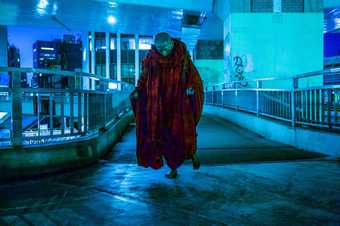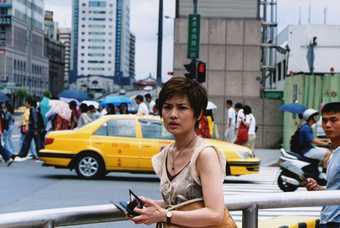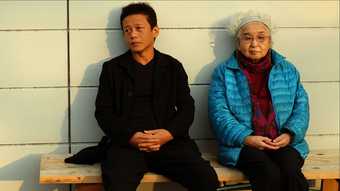This programme offers a chance to explore three of Tsai Ming-liang’s short films that point to different threads of his practice: interconnected narrative films, his ongoing Walker film series and documentary portraits and homages.
This programme is a chance to explore three of Tsai Ming-liang’s short films that point to different threads of his practice: interconnected narratives and films, his ongoing Walker film series and documentary portraits.
The Skywalk is Gone was made shortly after Tsai’s 2001 feature film What Time is it There?, extending and complicating elements of its plot. In it, we see the protagonist of the feature film attempt to locate a vendor from whom she had purchased a watch, only to find that the pedestrian overpass where he sold his wares has been removed, frustrating foot traffic. Midway through the film, the camera switches course to follow the former vendor, who is now auditioning for a role in a pornographic film, a plot line which carries through to Tsai’s 2005 feature The Wayward Cloud.
No No Sleep is the seventh instalment of Tsai’s Walker series, which follows the character of a Buddhist monk as he walks through the streets of various cities around the globe. Described by Tsai as ’an outdoor life drawing’, this iteration sees him slowly walking through Tokyo in the evening, carefully framed by Tsai’s steady camera. No No Sleep marks a break from previous instalments by veering away from the character in a remarkable tracking shot taken through the window of an urban train journey. The film then re-acquaints us with the monk in the setting of a public bathhouse where the homoerotic undertones characteristic of Tsai’s work bubble gently to the surface.
Autumn Days is a documentary portrait of Nogami Teruyo, a close friend of Tsai’s who worked for nearly fifty years as screenwriter and script supervisor for famed Japanese filmmaker Akira Kurosawa. In the first part of the film, she speaks with actor Lee Kang-sheng about her work with Kurosawa in a conversation that is heard but not seen, unfolding against a black screen. The second part is a filmic portrait in which Teruyo and Lee are seen but not heard as the camera moves through incrementally wider shots of the pair sitting on a bench amidst fallen leaves. Tsai states, ‘I wanted to preserve her portrait, as a gift to Japan and children of the future.’
Programme
Curatorial introduction
The Skywalk is Gone, Taiwan 2002, DCP, colour, sound, 22 min., Mandarin with English subtitles
No No Sleep, Taiwan 2015, DCP, colour, sound, 34 min.
Autumn Days, Taiwan 2015, DCP, colour, sound, 24 mins, Japanese and Mandarin with English subtitles
Please note this programme contains scenes of nudity.





